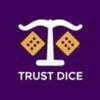I was at the craps table at Caesar’s in Canada. My established point to make was nine. I threw the dice and they hit the backboard with the six landing on the table and the three landing on top of the six. It was not leaning on one side or the other. Nobody working at the table or playing ever had seen this before. However, they said it was in the rulebook as a No Call. I could have thrown the dice a thousand times and not duplicated that again. Is this in the rulebook for all casinos? Have you ever seen this happen? Ray A.
Recently, while pulling down Christmas decorations from the attic, I came upon a table game rules handbook from one of the smaller joints that I worked at. As to your scenario, one die on top of another, the closest directive from the manual was this stand-alone, one liner; “Any dice not showing all of its spots is a No Call.”
Nonetheless, without being there and observing exactly the way the dice were stacked, I am going to punt and trust the judgment of the boxman who made the call. That is not to say that I, nor any other sitting box, would have made the same decision. A die on a forty-five degree angle lying against chips induces different calls all the time.
Craps is a chaotic game, Ray, and a boxman needs to make split-second decisions that are not always favorable to the player. Although the call was not advantageous to you, it most likely was the correct decision based on his interpretation of the rules.
…and then there was this time when I was boxing a $1 crap game, the point was four, and a die flew off the table and down a young ladies blouse, and somehow got stuck in her undergarment. Without hesitation, she unbuttoned her blouse, then her bra, and out pops, among other things, a two tumbling to the table, matching side-by-side the two already on the felt. Knowing the casino had less than thirty dollars at risk, I couldn’t resist, overrode the stickman’s legitimate “no call,” and yelled, “two spots and two dots. Pay the Pass line.”
Has legal sports betting been around as long as casino gambling, or vice versa? Elliot R.
Even though the Greeks were betting on footraces long before Bavarian immigrant Charles Fey invented the slot machine, legalized casino gambling in the US came first.
In 1931, gambling was legalized throughout the state of Nevada, whereas it wasn’t until 1949 that Nevada allowed bookmakers to accept bets on professional sports and horse racing.
At first, these bookie parlors were called Turf Clubs, and were independent and separate from the casinos, until 1975 that is. That is when Frank Rosenthal, who ran the Stardust, convinced state legislators to allow sport books into the casinos, causing the demise of Turf Clubs, which were no longer able to compete.
Gambling Wisdom of the Week: The population of Las Vegas, NV in 1910 was only 30.




















